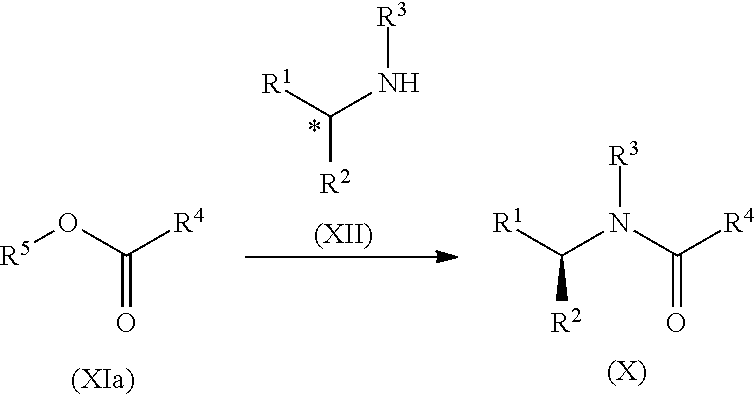Process for the preparation of lisdexamfetamine and related derivatives
- Summary
- Abstract
- Description
- Claims
- Application Information
AI Technical Summary
Benefits of technology
Problems solved by technology
Method used
Image
Examples
example 1
Boc-L-Lys(Boc)-OH
[0206]
[0207]A 2 L three-neck flask equipped with a mechanical stirrer was charged with a solution of L-lysine monohydrochloride (50.03 g, 274 mmol) in water (275 ml), 1,4-dioxane (275 ml) and 1 M sodium hydroxide solution (275 mmol, 275 ml) (resulting: pH 10.0). To this solution was added di-tert-butyl dicarbonate (179 g, 820 mmol) in one portion whilst stirring. The evolution of gas was noted, and the pH of the reaction mixture slowly decreased. A Metrohm Titrino 702 SM dosing unit was set up in “Set Endpoint Titration” mode in order to keep the pH of the reaction mixture constant at pH 7.30 by automatically dosing 1 M NaOH. Note: the reaction mixture apparently formed a buffered system at pH 7.05.
[0208]LCMS (NQAD detection) indicated near-complete consumption of the lysine starting material after a reaction time of 20 h. The reaction mixture was concentrated by rotary evaporation to a total volume of ˜500 mL. Water (250 mL) was added (resulting pH: 8.8) and then E...
example 2
Boc-L-Lys(Boc)-OMe
[0213]
[0214]A 1 L three-neck flask equipped with addition funnel, nitrogen inlet, thermometer and mechanical stirrer was charged with a solution of Boc-L-Lys(Boc)-OH (59.37 g, 161 mmol, 94 wt % in EtOAc) in N,N-dimethylformamide (anhydrous) (300 mL). Whilst stirring, potassium carbonate (24.5 g, 177 mmol) was added, and the resulting suspension was cooled on an ice bath to an internal temperature of +10° C. Iodomethane (34.3 g, 242 mmol, 15.04 mL) was added dropwise over 30 min via the addition funnel, while keeping the internal temperature 3 (0.5 L), and then extracted with EtOAc (3×500 mL). The combined organic phases were washed with dilute brine (2×200 mL), brine (2×100 mL), then dried over Na2SO4 and concentrated. After stripping with heptane (2×200 mL), the title compound was isolated as a white solid (57.08 g, 97% yield).
[0215]1H-NMR (CDCl3): In agreement with structure.
[0216]LCMS (NQAD detection): Purity >99%, mass in agreement with molecular formula (pos. ...
example 3
(S,S)-Bis-Boc-Lisdexamfetamine
[0219]
[0220]Inside a 100 mL three-neck flask equipped with a mechanical stirrer (teflon blade), a reflux condenser and a drying tube (CaCl2), a solution of Boc-L-Lys(Boc)-OMe (prepared as in Example 2 above, 5.01 g, 13.90 mmol) in acetonitrile (10 mL) was prepared. The resultant mixture was heated to 40° C. and then 1-phenylpropan-2-amine (9.38 g, 69.4 mmol) was added, followed immediately by addition of the protease of Bacillus licheniformis on solid support (ChiralVision P6-T2-250) (2.5 g). The resultant mixture was stirred at 100 rpm at 40° C. for 68 h, after which time HPLC and LCMS indicated virtually complete consumption of the starting material. The reaction mixture was decanted with the aid of MeCN (3×50 mL) and the decanted liquids were passed through a paper filter. The volatiles of the filtrate were removed in vacuo resulting in a yellowish oil to which water (200 mL) and 1 M KHSO4 (50 mL) were added (resulting in pH 2). The phases were separ...
PUM
| Property | Measurement | Unit |
|---|---|---|
| enantiomeric excess | aaaaa | aaaaa |
| temperature | aaaaa | aaaaa |
| temperature | aaaaa | aaaaa |
Abstract
Description
Claims
Application Information
 Login to View More
Login to View More - R&D
- Intellectual Property
- Life Sciences
- Materials
- Tech Scout
- Unparalleled Data Quality
- Higher Quality Content
- 60% Fewer Hallucinations
Browse by: Latest US Patents, China's latest patents, Technical Efficacy Thesaurus, Application Domain, Technology Topic, Popular Technical Reports.
© 2025 PatSnap. All rights reserved.Legal|Privacy policy|Modern Slavery Act Transparency Statement|Sitemap|About US| Contact US: help@patsnap.com



